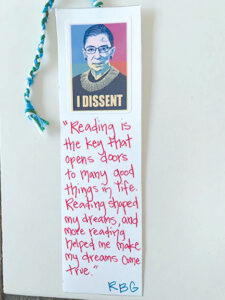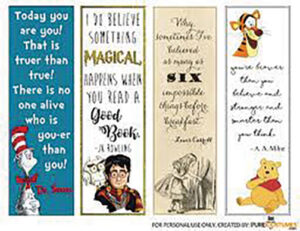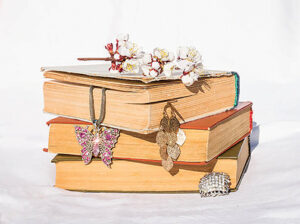 By Joan L. Huegel
By Joan L. Huegel Home from an auction one night, my husband grumbled as he struggled with three big boxes of books I bought. I bid on the books without knowing what they were, but I figured if I ended up with only two or three books that I liked and would keep, my dollar would have been well spent. My weakness has always been books, so much so that they’ve practically taken over the house. I had run out of shelf space long ago, and I hated to admit it to him, but I, too, wondered just what I would do with these.
Excited, I sat on the floor, rummaged through the boxes, and was disappointed since most of the books were in terrible condition. In one book, though, I found an old bookmark, and I was hooked immediately. Leather, this one was quite different from any bookmark I had seen, or rather, paid attention to. Obviously, I’d been around many bookmarks in my time.
Since then, though, I do pay attention to them and am now a bookmark collector.
 Bookmarks have undoubtedly been in existence since the first books were published, and we can imagine why they were made. At that time, books were extremely expensive, rare and delicate. It was bad for a book to turn down the corner of its page to hold or mark one’s place. Even today we know we shouldn’t treat a book that way. Book publishers, authors and collectors all cringe at the thought of someone doing that to a book. Unfortunately, many did, and do, and so the term “dog-eared” pages. So I’m sure it was the very first book owners, wishing to preserve their precious commodities, who devised the first bookmark.
Bookmarks have undoubtedly been in existence since the first books were published, and we can imagine why they were made. At that time, books were extremely expensive, rare and delicate. It was bad for a book to turn down the corner of its page to hold or mark one’s place. Even today we know we shouldn’t treat a book that way. Book publishers, authors and collectors all cringe at the thought of someone doing that to a book. Unfortunately, many did, and do, and so the term “dog-eared” pages. So I’m sure it was the very first book owners, wishing to preserve their precious commodities, who devised the first bookmark. In museums, I’ve seen some early ones made from thin sheets of gold with jeweled tops (supposedly for royalty), and some made from silver. As books became more available to more people, bookmarks did, too, and thin strips of fabric, leather and finally paper were used. A few publishers, mostly of Bibles, built bookmarks right into the book—long, narrow strips of ribbon.
Then, as now, some bookmarks were real works of art. About the mid-1800s, artist Thomas Stevens, who made woven pictures, made a limited number of his exquisite designs on ribbon for use as bookmarks. It was about 1862 when these became popular, and they are rare today, eagerly sought after and bring high prices. They are called Stevengraphs.
 It wasn’t long before businessmen and manufacturers saw the bookmark as a good means of advertising, and paper bookmarks promoting anything from Edison’s new talking machine to iron bitters were given away free. Generally they were about 5-1/2″ to 6-1/2″ long by about 2″ wide, and the most popular illustrations seemed to be women, children and flowers. As bits of history, they sometimes show what goods and services were available at a certain period of time, and they often reflect the visual style of a time period.
It wasn’t long before businessmen and manufacturers saw the bookmark as a good means of advertising, and paper bookmarks promoting anything from Edison’s new talking machine to iron bitters were given away free. Generally they were about 5-1/2″ to 6-1/2″ long by about 2″ wide, and the most popular illustrations seemed to be women, children and flowers. As bits of history, they sometimes show what goods and services were available at a certain period of time, and they often reflect the visual style of a time period. Many are lovely and lend themselves perfectly to framing and displaying. Those from around the turn of the century are often flowery Art Nouveau, and you’ll find many examples of Art Deco on the bookmarks of the ’30s.
Also during this period, bookmarks of celluloid were quite popular. Some advertising ones were given away, while others were for sale, and there was quite a wide variety. Some collectors specialize in these celluloids.
For generations people have been making their own bookmarks. Tatting and crocheting are old arts, and the tatted bookmark, usually a cross, was a very popular item for women to make. Although styles have changed, the creativity and industry of women hasn’t, and they are still making beautiful handcrafted bookmarks today.
 If you think you’d like to collect bookmarks, it’s easy getting started and there’s much available. It’s a very inexpensive hobby. Although not as plentiful as before, some are still given away free by a few merchants. The best sources now are the book stores and libraries. Starting a collection is as easy as walking into one of the book shops or library and picking up the free one. The ones containing the name of the business or library, and its location, that is a city and state, are most preferred by collectors and go into the “advertising category.” Be sure and let people know you are now collecting these gems, and you’ll begin receiving them in your mail. Bookmarks are perfect for sending with cards, notes and letters.
If you think you’d like to collect bookmarks, it’s easy getting started and there’s much available. It’s a very inexpensive hobby. Although not as plentiful as before, some are still given away free by a few merchants. The best sources now are the book stores and libraries. Starting a collection is as easy as walking into one of the book shops or library and picking up the free one. The ones containing the name of the business or library, and its location, that is a city and state, are most preferred by collectors and go into the “advertising category.” Be sure and let people know you are now collecting these gems, and you’ll begin receiving them in your mail. Bookmarks are perfect for sending with cards, notes and letters. All kinds are available today, ranging from paper to sterling silver. And there are numerous styles sold as souvenirs from every state and country. Commemoratives are still being issued, so watch for these, usually free. Most collectors highly prize their antique bookmarks and add these jewels to collections whenever possible. And yet most of us don’t limit our collecting to the old ones, either. We like them all. We realize that today’s ephemera could be tomorrow’s treasure.
The number of bookmark collectors is growing. I’m sure they would agree that collecting is interesting, challenging, and most of all, fun.
And bookmarks take up far less room than books!















Follow Us